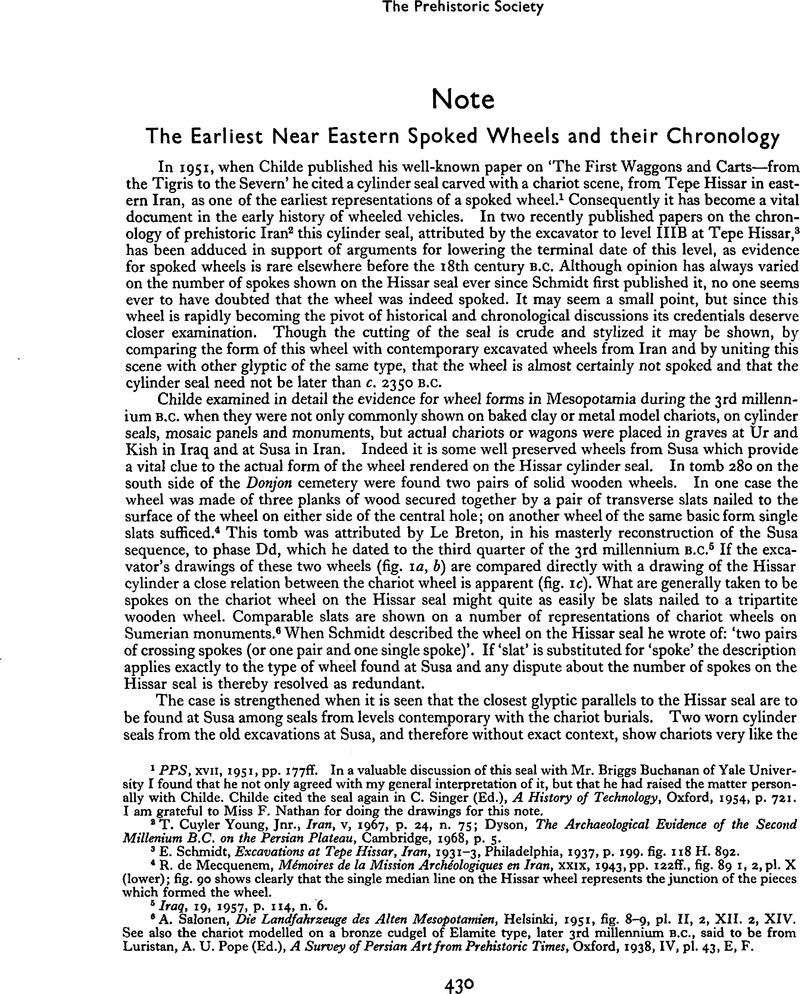No CrossRef data available.
Article contents
The Earliest Near Eastern Spoked Wheels and their Chronology
Published online by Cambridge University Press: 27 May 2014
Abstract

- Type
- Note
- Information
- Copyright
- Copyright © The Prehistoric Society 1969
References
1 PPS, XVII, 1951, pp. 177ffGoogle Scholar. In a valuable discussion of this seal with Mr. Briggs Buchanan of Yale University I found that he not only agreed with my general interpretation of it, but that he had raised the matter personally with Childe. Childe cited the seal again in Singer, C. (Ed.), A History of Technology, Oxford, 1954, p. 721Google Scholar. I am grateful to Miss F. Nathan for doing the drawings for this note.
2 Young, T. Cuyler Jnr., Iran, V, 1967, p. 24Google Scholar, n. 75; Dyson, , The Archaeological Evidence of the Second Millenium B.C. on the Persian Plateau, Cambridge, 1968, p. 5Google Scholar.
3 Schmidt, E., Excavations at Tepe Hissar, Iran, 1931–1933, Philadelphia, 1937, p. 199Google Scholar. fig. 118 H. 892.
4 de Mecquenem, R., Mémoires de la Mission Archéologiques en Iran, XXIX, 1943, pp. 122ff.Google Scholar, fig. 89 1, 2, pl. X (lower); fig. 90 shows clearly that the single median line on the Hissar wheel represents the junction of the pieces which formed the wheel.
5 Iraq, 19, 1957, p. 114Google Scholar, n. 6.
6 Salonen, A., Die Landfahrzeuge des Alten Mesopotatnien, Helsinki, 1951Google Scholar, fig. 8–9, pl. II, 2, XII. 2, XIV. See also the chariot modelled on a bronze cudgel of Elamite type, later 3rd millennium B.C., said to be from Luristan, A. U. Pope (Ed.), A Survey of Persian Art from Prehistoric Times, Oxford, 1938, IVGoogle Scholar, pl. 43, E, F.
7 Delaporte, L, Catalogue des Cylindres Orientaux ….. du Musée du Louvre, Paris, 1, 1920Google Scholar, nos. S.456–7, pl. 32. 8. 9
8 For similar chariot scenes see Amiet, P., La Glyptique Mésopotamienne Archaique, Paris, 1961Google Scholar, nos. 1212–1217, 1260, 1435.
9 Dyson, R. in Ehrich, R. W., Chronologies in Old World Archaeology, London, 1965, pp. 240–1Google Scholar. The absolute chronology adopted in this note is that of the revised Cambridge Ancient History: the so-called ‘Middle Chronology’ which dates the reign of Hammurabi c. 1792–1750 B.C.
10 Dossin, G., Archives Royales de Mari, 1, Paris, 1950,Google Scholar no. 50.
11 Ziegler, C., Die Terrakotten von Warka, Berlin, 1962Google Scholar, no. 137, pl. 8.
12 Figulla, H., Cuneiform Texts from Babylonian Tablets in the British Museum, XLVII, London, 1967Google Scholar, no. 22, pl. 14.
13 For example, Porada, E., The Collection of the Pierpont Morgan Library, CANES, 1, 1948Google Scholar, no. 971; von der Osten, H. H., Ancient Oriental Seals … Mr. Edward T. Newell, Chicago, 1934Google Scholar, no. 341.
14 For very clear examples see E. Porada, op. cit., no. 893; Özgüç, T., Kultepe Kazisi Raporu 1949, Ankara, 1953Google Scholar, pl. LXIV, 714.
15 de Genouillac, , Céramique Cappadocienne, 1, Paris, 1926, fig. 58–59, II, p. 41Google Scholar, pl. 28–9.
16 Mallowan, M. E. L., Iraq, III, 1936, p. 21Google Scholar; IV, 1937, p. 96, fig. 10. 31—twelve or more spokes are indicated if the design is taken at face value; for similar equivocal designs on model chariot wheels see de Mecquenem, op. cit., fig. 91a (Susa); McCown, D. E., Nippur, I, Chicago, 1967, p. 94Google Scholar.
17 See most recently de Vaux, R., Revue Biblique, 74, 1967, pp. 484ffGoogle Scholar. for the Hurrians and early chariotry.
18 A. Salonen, op. cit., p. 120.




